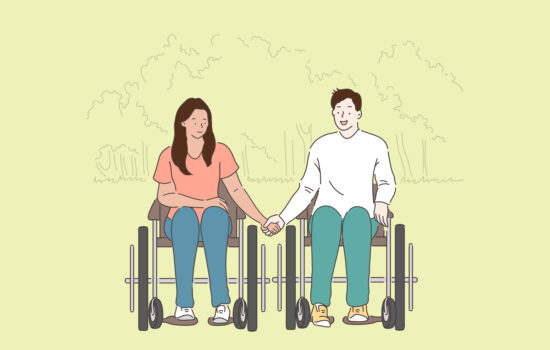Adaptive aids are devices, controls or appliances which enable persons with physical limitations to improve their ability to carry out activities of daily living such as dining, dressing and grooming. Many of these devices are modifications or alterations to commonly used items to help persons with disabilities perform everyday tasks without the need for caregivers’ help or assistance. This facilitates self-reliance and independent functioning, thereby increasing self-confidence and enhances personal quality of life. Ms Poh Sho Siam, senior analyst in SPD’s advocacy team, introduces us to some of these aids.
| Dining | |
.jpg)
Image source: RehabMart |
Easy Grip Utensils
Easy grip utensils are designed with large handles that are easy to grasp and hold on to in a variety of positions, which could help persons who are unable to firmly hold on to utensils with small handles, like those with hand tremors or poor hand control. Some of these utensils have a special twist built into the metal shaft that allows them to be adjusted to any angle and be bent for use with either the right or left hand. |
.jpg)
Image source: North Coast Medical |
Utensil Hand Strap
Utensils could be slid into the pocket of the utensil hand strap to help a person with limited or no grasp to hold up a utensil. The straps are usually adjustable to fit different palm sizes. It could also be used to hold other objects such as writing instruments, toothbrushes or other small items. |
.jpg)
Image source: The Wright Stuff |
Non-slip Scoop Plate
The plate is deeper on one edge than the other to allow for easier scooping. The suction pad at the base prevents the plate from moving during eating. This could assist persons with hand tremors and those with restricted hand movement to dine independently. |
.jpg)
Image source: North Coast Medical |
Straw Holder
A straw holder could be clipped to the lip of glasses and cups. It keeps the straw in place and helps a person who is unable to hold on to a glass to drink from it. |
.jpg)
Image source: The Wright Stuff |
Dysphagia Cup
The Dysphagia Cup is designed for persons who have difficulty swallowing. Users drink from the tall side of the cup, allowing them to keep their chin in a lowered position while drinking and encourages better swallowing. The design of the cup directs liquids to the centre of the mouth and provides nose clearance to empty the cup without tilting the head back. The large handle is designed for ease of gripping. |
| In the Kitchen | |
| Mounted Can Opener
This type of can opener could be mounted to a wall or under a counter. The user slips the jar top or bottle top into the steel jaws of the can opener until it wedges and turns the jar. The can opener allows the opening of the jar with one hand. |
.jpg)
Image source: The Wright Stuff |
| Jar Gripper
The jar gripper makes opening of stiff jar lids easier for persons with arthritic hands or those with reduced grip strength. The jar gripper often has grooves/ridges on the outside to allow the user to get a good grip when twisting, and ribbing on the inside to ensure a firm hold on the lid. They are usually made of silicone or rubber which is flexible to fit various lid sizes and shapes and they could also be used to open handles and doorknobs. |
.jpg)
Image source: Complete Care Shop |
| Knob Turner
A knob turner could aid those who have difficulties turning small knobs like those on stoves, toasters or washing machines. The large handle makes gripping easier. The head of the turner has a bed of sprung stainless steel rods, which when pressed around an object, retract, conform around its shape, and provide a purchase around it when the handle is turned. |
.jpg)
Images source: Complete Care Shop |
| Easy Grip Scissors
These easy grip scissors are operated with whole hands and not just fingers. The scissors self-open when the pressure is released and can be operated with the right or left hand. The self-opening handle makes it easier for persons with thumb injuries or weakened hands to operate a pair of scissors. |
%20Ltd].jpg)
Image source: Peta (UK) Ltd |
| Reachers
Reachers could be used for reaching, gripping and retrieving items from hard-to-reach low or high level places. Some of them have forearm support to provide extra support for persons with weaker arms.
|
.jpg)
Image source: Disabled Living Foundation |
| Dressing and Grooming | ||
.jpg)
Elastic Shoe Laces Image source: ALS Hope Foundation |
.jpg)
Lock Laces Image source: The Wright Stuff |
Elastic Shoe Laces and Lock Laces
Elastic shoe laces do not require tying and untying and makes it possible to quickly slip shoes on and off. This helps persons who have difficulties bending over or limited hand dexterity to wear shoes without assistance. Similarly, lock laces do not require tying. The shoe laces could be tightened by pressing or squeezing the button on the clasp or clip, and pulling the lace through. The shoe laces are ‘locked’ when the button is released. |
.jpg)
Fall Management Socks Image source: Repton Medical |
.jpg)
Fall Management Slippers Image source: MTS Medical Supply
|
Fall Management Socks and Slippers
The slip-resistant rubber tread printed on both the top and bottom of the fall management sock provides traction when walking. The two-sided rubber tread provides traction even if the socks are twisted. Fall management slippers are helpful for users who are unable to wear full support footwear. The rubber soles offer a firm grip for safer ambulation. |
.jpg)
Image source: RehabMart |
Sock Aid
The sock aid has a plastic moulded sleeve which the sock is fitted over and holds the sock open. The user than slide his foot into the sock and pull on the cords to pull up the sock over the foot. This assists persons who are unable to bend over to pull on socks and stockings in a seated position without relying on a caregiver. |
|
.jpg)
Image source: RDK Mobility |
Zipper Pulls
The rings could be attached to zipper tabs on clothing, jackets or any zippered item. The large ring is easier to handle and requires less strength to pull on than the common small zipper tabs found on most clothing. |
|
.jpg)
Image source: Complete Care Shop |
Dressing Stick
The dressing stick makes it easier for persons with the use of only one arm or other mobility limitations to get dressed. It is a long wooden handle with different sized hooks on its ends to help in pulling up slacks or skirts, putting on shirts or jackets, etc. |
|
.jpg)
Image source: Easy Comforts |
Foot Brush
The foot brush allows for hands-free foot washing without bending over. It has a suction base to attach it to a tub or shower floor, reducing the risks of slipping and falling during cleaning.
|
|
| Image source: DisabilityProducts |
Long Handle Comb and Brush
The big handle makes the comb or brush easier to grip and hold in the palms. The long contoured handle is shaped to follow the curve of the head, allowing the handle to be held close to the body. This helps reduce strain and uncomfortable reaching for those with limited mobility. |
|
Not only are adaptive aids useful to persons with physical limitations and those with physical disabilities, they could also be beneficial to persons with other needs, for instance, persons recovering from injuries, the elderly and children. In some cases, users may modify items or create similar devices on their own to suit their needs. As some of these devices are smartly designed, they could also increase convenience for users without any disabilities.
This content has been put together with references from several adaptive aids providers’ websites, including Complete Care Network Ltd (UK), DisabilityProducts.com (US), Disabled Living Foundation (UK), Easy Comforts (US), Mobility Transfer Systems Inc (US), North Coast Medical Inc (US), Peta (UK) Ltd, RDK Mobility (UK), RehabMart.com (US), Repton Medical Ltd (UK) and The Wright Stuff Inc (US).




